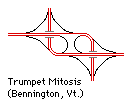Trumpets, and other 3-way interchanges

This is a conceptually simple way to end one freeway at another. Like a cloverleaf, it requires only one or two bridges, and designing for higher speed will take up more land. Alternatives to the trumpet, shown below, usually involve more bridges but remove the loop ramp.
Often an interchange involving a toll freeway to another freeway will be a double trumpet, with all connecting traffic stopping at a toll station between the trumpets. Sometimes more roads join in. The end of the Pennsylvania Turnpike at I-81 and US 6 near Scranton has a triple trumpet. And I-90, I-91 and US 5 in Springfield, Mass. connect via a quadruple trumpet (see map).
Michael G. Koerner reports that the new US 30/OH 696 interchange (see map) near Beaverdam, Ohio is an "inside trumpet": the westbound mainline follows the high-speed ramp outside the loop, the southbound ramp diverges from the left, and the northbound to westbound loop traffic converges from the left.
Fused Trumpet

Of the several "which page should this go on?" interchanges is Vermont's treatment of the US 7 / VT 67A interchange near Bennington (see map). The four-way interchange is built from two trumpets fused together, giving the appearance of a single trumpet undergoing cell division.
The fused trumpet would seem to serve interchanges where the mainlines "bump" (intersect but do not cross; as in I-80 and I-76 near Youngstown, Ohio). The eastern connection at Bennington is not currently used, but as of 2012 the eastern leg of the Bennington Bypass is under construction.
Thanks to Mike Moroney for this one.
Directional T

Informally known as the "New England Y," this design is often seen in the urban United States, especially the northeast. It features directional ramps (no loops, or weaving right to turn left) which can be built fairly wide (multilane) in comparatively little space. Some designs have two ramps and the "inside" thru road (on the same side as the freeway that ends) crossing each other at a three-level bridge.
The Bad Thing about this design: Left Exits. On right-side driving roads, it's better to have traffic enter and exit from the right side, so high-speed thru traffic can drive on the left without interference. How to get rid of the left exits is left to you as an exercise; solution below. However, if left- and thru- or right-turning traffic volumes are close to equal, the left-exit problem diminishes because there's not such an obvious "mainline" road.
William H. Riddle (Tennessee Highways) has found 10 Directional T's in his state and recommends that "the term 'New England Y' be officially retired and replaced with either the term 'Tennessee T' or 'Nashville T.'"
Semi-Directional T

Lacking the problem left exits, this design is a good choice for high traffic junctions. The ramps can be made two or three lanes wide for more capacity. It's semi-directional, meaning cars veer right before crossing both carriageways to the left, but the turns are gradual.
Links
- Interchanges
- Glossary
- Culture: interchanges in movies, computer games, etc.
- Diamond and other 4-ramp designs
- Six-ramp partial cloverleaf
- Cloverleaf
- Trumpet and other 3-way interchanges
- Stack and other heavy-duty 4-way interchanges
- Volleyball: an odd 3-level 4-way treatment
- SPUI: Single-Point Urban Interchange
- Oddities: Some strange or fictional interchanges